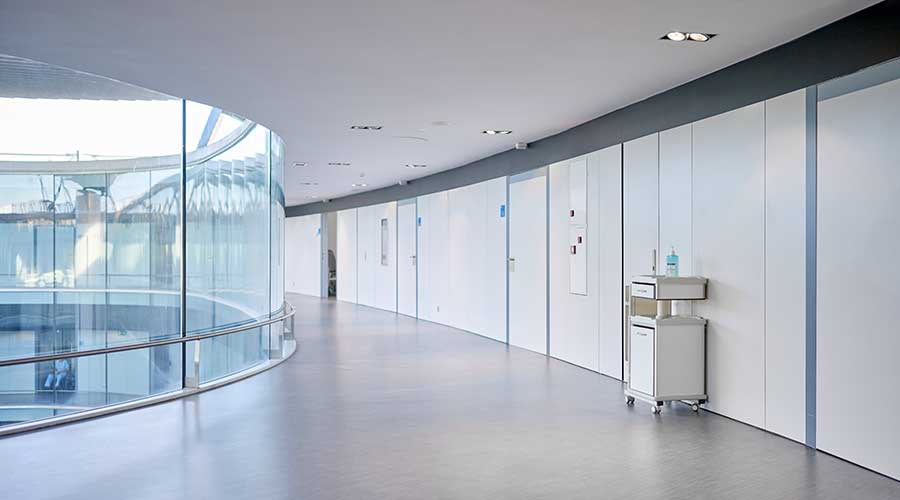Longer life expectancies and a growing global population are pushing medical resources to the limit and there is intensifying pressure on the healthcare industry to look at new ways to boost efficiency and save lives, while keeping costs to a minimum. As such, many leading hospitals are already embracing wireless technology as a means of enhancing both patient care and productivity. The uses for wireless in a healthcare environment have advanced significantly over the last few years. As well as providing comfort and mobility to patients, wireless medical telemetry devices allow hospitals to better manage resources and improve medical efficiency and practices. In addition, patients, visitors and healthcare professionals expect to be able to communicate with families, friends and colleagues at all times.
Wireless challenges in hospitals
Hospitals come in many different shapes and sizes, and have been built using numerous specialized construction materials, but this can often cause a number of issues. Indeed, the hospital’s building structure can make it extremely difficult to provide ubiquitous in-building wireless services. For example, 4G LTE signal, operating at high frequencies such as 2.1 GHz, simply does not penetrate building walls as well as 2G or 3G services. As such, hospitals will be left with areas that have reduced data rates or even complete loss of signal, which could be critical in intensive care and special units. What’s more, in hospitals with multiple floors, there will likely be several adjacent cell sites providing signal to the building. Therefore, hospital staff and patients’ mobile phones will likely jump from one mobile cell site to another, which can significantly degrade mobile service. To overcome this, there must be a sufficiently strong signal source inside the building that is able to deliver adequate mobile coverage while ensuring mobile devices stay “locked on” to the signal.
There’s also the issue of providing enough capacity in hospitals. In high user density areas such as waiting rooms, mobile capacity can become extremely limited because the signal is concentrating on serving the peak crowd of users who are all contacting their families or accessing the internet from their mobile devices. These temporary demands on the network can significantly impair mobile service performance and availability. Therefore, hospitals should consider wireless technology that can be sectorized and deliver the necessary capacity to each area within the hospital. Sectorization is a long-standing method of expanding wireless network capacity and dates back to macro cells around 20 years ago – it is often used in stadiums or public venues to expand capacity.
Hospital health and safety
Hospitals are obliged to optimize wireless coverage throughout their facilities. Many hospitals are chosen to be a special coverage location center point for the emergency services. As such, a robust network is needed in all departments supporting the multiple types of frequency bands used by fire, police and ambulance services. Poor signal or wireless black spots could ultimately lead to dangerous lapses in patient monitoring and communication systems.
While optimizing the wireless signal makes sense, hospital management teams are also worried that the amount of radiation generated as a result of installation could impact equipment and overall safety. To eliminate these safety concerns, hospitals need a solution that can provide ubiquitous wireless coverage to areas that are unconnected, and with safety and performance risks kept to an absolute minimum.
Enhancing wireless coverage in hospitals
In order to overcome the challenges associated with wireless coverage in hospitals and provide a strong and reliable mobile signal for both critical communication and commercial services, hospital management teams should optimize the network infrastructures with technology such as a fiber-based, wideband active distributed antenna system (DAS). A wideband DAS is an install-once wireless signal distribution system consisting of small antennas which can fit unobtrusively inside hospital ceilings, meaning that there is little disturbance to the hospital building itself. These systems also bring the signal closer to the users and allow specific services to be easily routed around the hospital to areas where they are needed the most, such as intensive care units. Hospital wards can often be limited to voice services only for patient and privacy reasons, but with DAS, 4G hotspots can be created in pre-designated communal areas.
When it comes to radiation and interference, the risks with DAS are minimal because emission levels are negligible, but hospital management teams can often carry out a series of tests to determine this, putting staff and patient safety first. One of the key benefits of wideband DAS technology is the system’s network infrastructure, which is standard structured cabling – broadband single mode or multi-mode fiber. This means that the system design and installation is a simple and straightforward process, with minimal disruption to the hospital. Wideband DAS systems are also flexible and scalable, enabling upgrades or additions to be quickly implemented without needing any hardware replacements or cabling refits; this offers hospitals a future-proof solution and rapid return on investment (ROI).
An ‘evergreen’ hospital
Ultimately, wideband active DAS technology will allow hospitals to benefit from a fast, efficient and cost-effective wireless deployment, with minimal disruption to infrastructure, services, staff and patients. A truly wideband DAS is considered to be ‘evergreen,’ which means it can easily accommodate the addition of new frequencies and services without the addition of new hardware or cabling. This will be critical in hospitals as wireless medical continues to evolve and continues to save lives.
John Spindler is the vice president of marketing and product management for Zinwave.

 Healthcare Facilities Look to Future-Proof Facilities
Healthcare Facilities Look to Future-Proof Facilities Yale New Haven Health Experiences Data Breach
Yale New Haven Health Experiences Data Breach Rethinking Facilities: A New-Generation Approach to Behavioral Healthcare
Rethinking Facilities: A New-Generation Approach to Behavioral Healthcare ThedaCare to Open Medical Center in Fond du Lac, Wisconsin
ThedaCare to Open Medical Center in Fond du Lac, Wisconsin UF Health Hospitals Rely on Green Globes to Realize Their Full Potential
UF Health Hospitals Rely on Green Globes to Realize Their Full Potential